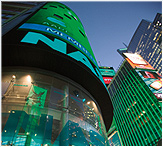Tuesday, May 22, 2012
Equity Trader Alert #2012 - 13
UPDATE: NASDAQ, BX and PSX Introduce Excessive Messaging Policy
Markets Impacted:Contact Information:
|
What you need to know:
|
|---|
Why are NASDAQ, BX and PSX instituting an Excessive Messaging Policy?
Robust liquidity provision, including depth of liquidity, is vital to modern equity markets and frequently updated displayed quotes generally promote efficient price discovery and provide essential liquidity. However, excessive quoting at prices away from the National Best Bid and Offer (NBBO) can result in a significant market data burden for participants and does little to improve the quality of the lit marketplace.
NASDAQ, BX and PSX are proposing an Excessive Messaging Policy that encourages active quoting near the NBBO while discouraging excessive order activity away from the inside. In this way, the exchanges seek to reduce non-marketable quote activity while protecting legitimate market making activity from incremental complexity and cost.
What is the Excessive Messaging Policy?
UPDATE 5/21/12: Effective July 2nd, NASDAQ, BX and PSX will introduce a policy intended to reduce excessive submission of non-marketable displayed orders to the exchange.
MPIDs that exceed a "Weighted Order-to-Trade Ratio" of 100:1 will pay a fee on the orders that cause them to exceed the threshold.
Order and trade activity by Registered Market Makers in their registered securities will be excluded from the ratio calculation.
What is the Weighted Order-to-Trade Ratio?
The Weighted Order-to-Trade Ratio is a measure of how often an MPID sends displayed, non-marketable liquidity-providing orders to the exchange that fail to execute.
It is similar to the "Orders to Orders Executed" ratio used by NASDAQ's ISP program, but also applies a Weighting Factor to each order based on its proximity to the NBBO at the time of entry.
UPDATE 5/21/12:The proposed weighting factors are:
| Order's Price vs NBBO upon entry | Weighting factor |
|---|---|
| 0 - %0.20 away | 0x |
| %0.20 - 0.99% away | 1x |
| 1% to 1.99% away | 2x |
| 2.00% or more away | 3x |
Which order types are included in the Weighted Order-to-Trade Ratio calculation?
Only displayed, liquidity-providing orders received during regular market hours will be included in the Weighted Order-to-Trade Ratio calculation.
Non-displayed orders, Immediate-or-Cancel (IOC) orders and Auction orders will not be included in the calculation.
Orders sent by Registered Market Makers in their registered securities will not be included in the calculation.
UPDATE 5/21/12: MPIDs sending less than 100,000 Weighted orders daily will not incur penalties. Previously, MPIDs submitting fewer than 1,000,000 unweighted orders were not subject to the penalty.
What will the penalty be for sending excessive messages?
UPDATE 5/21/12: MPIDs that exceed the Weighted Order-to-Trade Ratio threshold of 1,000:1 will pay a $0.01 per order penalty for their "Excessive Orders." MPIDs that exceed the Weighted Order-to-Trade Ratio threshold of 100:1 but less than 1,000:1 will pay a $0.005 per order penalty for their "Excessive Orders". Excessive Orders are orders that cause an MPID’s ratio to exceed 100:1. For example:
- ABCD sends the following displayed, liquidity-providing orders:
- 1,000,000 orders at the NBBO (weighting factor: 0x), of which 7,000 trade
- 500,000 orders 1.5% away from the NBBO (weighting factor: 2x), of which 1,000 trade
- ABCD's Weighted Order-to-Trade Ratio is 125:1
- Weighted Order Count: 1,000,000 (1,000,000 x 0 + 500,000 x 2)
- Orders executed (i.e., Trades): 8,000
- Therefore, the ratio is 125 = (1,000,000 weighted orders / 8,000 orders executed)
- Based on 8,000 orders executed, ABCD needed a weighted order count of 800,000 orders to meet the 100:1 threshold
- Therefore, the Excessive Order quantity is: 200,000 = (1,000,000 - 800,000)
- ABCD will incur a penalty of $0.005 on their 200,000 excessive orders.
UPDATE 5/21/12: Pending SEC review, the Excessive Messaging Policy will become effective July 2, 2012. This delay will allow members additional time to upgrade their systems to OUCH version 4.2 or 3.3. These versions of OUCH provide the "weighting factor" for each order entered, allowing firms to manage their weighted order count in real-time. Please refer to the posted OUCH specifications.
Where can I find more information?
- Contact Transaction Services U.S. Market Sales at +1 800 846 0477
Email Alert Subscriptions:
Nasdaq offers customers the ability to self select news delivery across various Nasdaq markets. Create and maintain a profile for updating alert preferences and contact information. Visit the enrollment form on the Nasdaq Trader website and sign up today! Please note that if you choose to unsubscribe from an email list, you may no longer receive potentially critical emails from the NASDAQ Stock Market regarding Nasdaq's trading and data products, regulatory issues or marketplace initiatives. To unsubscribe, also click on the enrollment form
Please follow Nasdaq on ![]() Facebook
Facebook ![]() RSS and
RSS and
![]() Twitter.
Twitter.
Nasdaq (Nasdaq: NDAQ) is a leading global provider of trading, clearing, exchange technology, listing, information and public company services. Through its diverse portfolio of solutions, Nasdaq enables customers to plan, optimize and execute their business vision with confidence, using proven technologies that provide transparency and insight for navigating today's global capital markets. As the creator of the world's first electronic stock market, its technology powers more than 90 marketplaces in 50 countries, and 1 in 10 of the world's securities transactions. Nasdaq is home to approximately 3,900 total listings with a market value of approximately $13 trillion. To learn more, visit: business.nasdaq.com.

 RSS Feeds
RSS Feeds Product Login
Product Login
